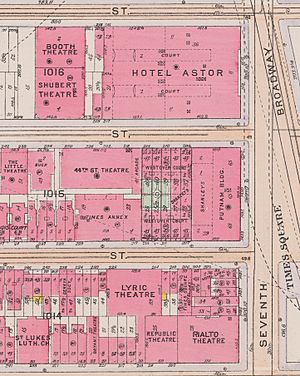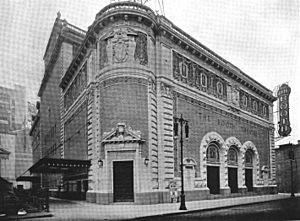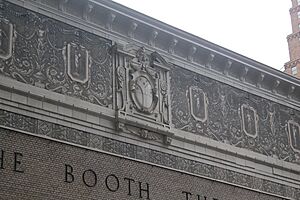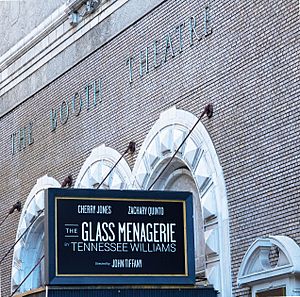Booth Theatre facts for kids
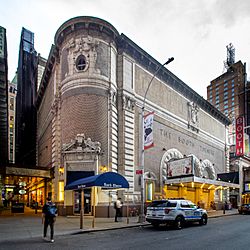 |
|
| Address | 222 West 45th Street Manhattan, New York United States |
|---|---|
| Coordinates | 40°45′30″N 73°59′13″W / 40.7584°N 73.9870°W |
| Public transit | Subway: Times Square–42nd Street/Port Authority Bus Terminal |
| Owner | Shubert and Booth Theatre, LLC |
| Operator | The Shubert Organization |
| Type | Broadway |
| Capacity | 800 |
| Production | Little Bear Ridge Road |
| Construction | |
| Opened | October 16, 1913 |
| Years active | 1913–present |
| Architect | Henry Beaumont Herts |
| Designated | November 4, 1987 |
| Reference no. | 1321 |
| Designated entity | Facade |
| Designated | November 4, 1987 |
| Reference no. | 1322 |
| Designated entity | Lobby and auditorium interior |
The Booth Theatre is a famous Broadway theater located at 222 West 45th Street in New York City. It opened in 1913 and was designed by architect Henry Beaumont Herts. The theater was built for the Shubert brothers, who were very important in the theater world.
The theater is named after the famous 19th-century American actor Edwin Booth. It was first run by Winthrop Ames, who wanted it to be a smaller, more intimate space for plays. The Booth Theatre has 800 seats and is operated by The Shubert Organization. Both its outside wall (facade) and parts of its inside are protected as New York City landmarks.
The building's design is inspired by the Italian Renaissance style. It has a unique look with brick, terracotta, and special plaster decorations called sgraffito. The theater shares a stage house with the Shubert Theatre next door.
Over the years, the Booth Theatre has been home to many famous and long-running shows. Some of these include Butterflies Are Free, That Championship Season, and The Elephant Man.
Contents
Location and Design
The Booth Theatre is in the heart of Manhattan's Theater District, near Times Square. It sits on a block with many other Broadway theaters. The theater is right next to the Shubert Theatre, and they were built as a pair. They share a private alley called Shubert Alley, which was originally created as a fire escape path.
The theater was designed by Henry Beaumont Herts. He wanted the Booth to be a smaller, cozier theater compared to the larger Shubert Theatre next door.
The Outside of the Theater
The outside walls, or facades, of the Booth and Shubert theaters look similar. They are designed in an Italian Renaissance style with brick and terracotta. A special feature is the use of sgraffito, a technique where layers of colored plaster are scratched to create a design. This was a new and unique way to decorate a building in New York City at the time.
The main entrance on 45th Street has three large arches. Above them, a sign spells out "The Booth Theatre." The building has a curved corner that faces Broadway, making it look inviting to people walking by.
Inside the Theater
The theater has a ticket lobby and an inner lobby. This design helps keep street noise out of the main performance area. In the inner lobby, there is a bust of the actor Edwin Booth, for whom the theater is named.
The auditorium, where the audience sits, has an orchestra level and one balcony. It can hold about 800 people. The walls are covered with dark wood panels, which is unusual for a Broadway theater. Above the panels are windows, which make the space feel more open. The ceiling is curved and has a beautiful plaster design with chandeliers.
The stage is framed by a large, elliptical arch called a proscenium. The overall design makes the theater feel elegant and charming, perfect for watching a play up close.
History of the Booth Theatre
In the early 1900s, Times Square became the center of theater in New York City. The Shubert brothers, Lee and Jacob J., were building many theaters. They teamed up with producer Winthrop Ames to build two theaters on land owned by the wealthy Astor family.
The larger theater became the Shubert Theatre, and the smaller one was named the Booth Theatre. Ames wanted the Booth to be a small, special venue. He named it after Edwin Booth because his own father had worked for the famous actor.
Opening and Early Shows
The Booth Theatre opened on October 16, 1913. The first show was a play called The Great Adventure. For nearly 20 years, Ames managed the theater and put on many of his own productions.
In the 1910s and 1920s, the Booth hosted many successful plays. The Green Goddess opened in 1921 and ran for 440 performances. Another big hit was Seventh Heaven in 1922, which had 683 performances. Famous actors like Helen Hayes, Alfred Lunt, and Lynn Fontanne performed on its stage during this time.
The Shubert Years
In 1932, Winthrop Ames retired, and the Shubert family took over managing the theater. The 1930s were a busy time, but many shows had short runs. However, one major success was the play You Can't Take It with You, which opened in 1936. It was so popular that it ran for 837 performances and won a Pulitzer Prize.
During the 1940s, shows at the Booth started to have longer runs. The comedy Blithe Spirit was a big hit, and The Two Mrs. Carrolls ran for 585 performances.
From the 1950s to the 1970s, the Booth continued to host famous plays.
- 1950: Come Back, Little Sheba starring Shirley Booth.
- 1964: The comedy Luv ran for about 900 performances.
- 1969: Butterflies Are Free was a huge success with 1,128 performances.
- 1972: That Championship Season won a Pulitzer Prize and ran for over 800 performances.
- 1979: The Elephant Man started a run of 916 performances.
Recent Decades
In the 1980s, the theater was home to the Pulitzer-winning musical Sunday in the Park With George and the long-running play I'm Not Rappaport. In 1987, the theater's exterior and interior were officially named New York City landmarks, protecting them for the future.
The 1990s saw the hit musical Once on This Island and several popular one-person shows. The 2000s brought more variety, including dramas, comedies, and musicals. The musical Next to Normal opened in 2009 and was a big success.
In recent years, the Booth has hosted many acclaimed plays and musicals.
- 2015: The play Hand to God had a successful run.
- 2018: A revival of The Boys in the Band set a box office record for the theater.
- 2020: The theater closed temporarily due to the COVID-19 pandemic.
- 2022: The musical Kimberly Akimbo opened and became a hit, running until 2024.
The theater continues to be a premier venue for exciting new productions on Broadway.
Famous Shows at the Booth
The Booth Theatre has hosted hundreds of shows. Here are some of the most notable productions from its long history.
- The Great Adventure (1913)
- The Green Goddess (1921)
- Seventh Heaven (1922)
- You Can't Take It with You (1936)
- Blithe Spirit (1942)
- Come Back, Little Sheba (1950)
- Visit to a Small Planet (1957)
- Two for the Seesaw (1958)
- Luv (1964)
- Butterflies Are Free (1969)
- That Championship Season (1972)
- For Colored Girls... (1976)
- The Elephant Man (1979)
- Sunday in the Park with George (1984)
- I'm Not Rappaport (1985)
- Once on This Island (1990)
- Having Our Say (1995)
- Next to Normal (2009)
- Who's Afraid of Virginia Woolf? (2012)
- Hand to God (2015)
- The Boys in the Band (2018)
- Kimberly Akimbo (2022)
See also
 In Spanish: Teatro Booth para niños
In Spanish: Teatro Booth para niños
- List of Broadway theaters
- List of New York City Designated Landmarks in Manhattan from 14th to 59th Streets


